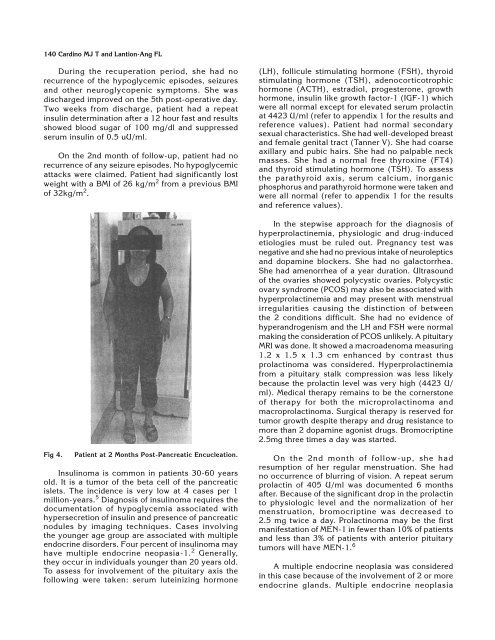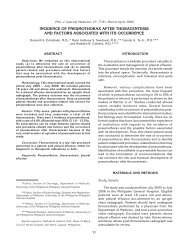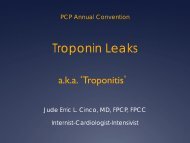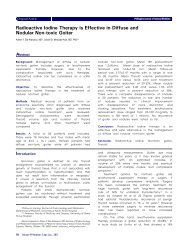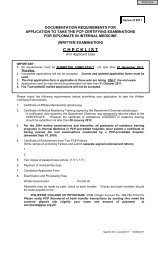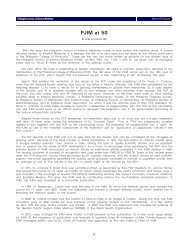Insulinoma and Prolactinoma in A Young Female - Philippine ...
Insulinoma and Prolactinoma in A Young Female - Philippine ...
Insulinoma and Prolactinoma in A Young Female - Philippine ...
You also want an ePaper? Increase the reach of your titles
YUMPU automatically turns print PDFs into web optimized ePapers that Google loves.
140 Card<strong>in</strong>o MJ T <strong>and</strong> Lantion-Ang FLDur<strong>in</strong>g the recuperation period, she had norecurrence of the hypoglycemic episodes, seizures<strong>and</strong> other neuroglycopenic symptoms. She wasdischarged improved on the 5th post-operative day.Two weeks from discharge, patient had a repeat<strong>in</strong>sul<strong>in</strong> determ<strong>in</strong>ation after a 12 hour fast <strong>and</strong> resultsshowed blood sugar of 100 mg/dl <strong>and</strong> suppressedserum <strong>in</strong>sul<strong>in</strong> of 0.5 uU/ml.On the 2nd month of follow-up, patient had norecurrence of any seizure episodes. No hypoglycemicattacks were claimed. Patient had significantly lostweight with a BMI of 26 kg/m 2 from a previous BMIof 32kg/m 2 .(LH), follicule stimulat<strong>in</strong>g hormone (FSH), thyroidstimulat<strong>in</strong>g hormone (TSH), adenocorticotrophichormone (ACTH), estradiol, progesterone, growthhormone, <strong>in</strong>sul<strong>in</strong> like growth factor-1 (IGF-1) whichwere all normal except for elevated serum prolact<strong>in</strong>at 4423 U/ml (refer to appendix 1 for the results <strong>and</strong>reference values). Patient had normal secondarysexual characteristics. She had well-developed breast<strong>and</strong> female genital tract (Tanner V). She had coarseaxillary <strong>and</strong> pubic hairs. She had no palpable neckmasses. She had a normal free thyrox<strong>in</strong>e (FT4)<strong>and</strong> thyroid stimulat<strong>in</strong>g hormone (TSH). To assessthe parathyroid axis, serum calcium, <strong>in</strong>organicphosphorus <strong>and</strong> parathyroid hormone were taken <strong>and</strong>were all normal (refer to appendix 1 for the results<strong>and</strong> reference values).In the stepwise approach for the diagnosis ofhyperprolact<strong>in</strong>emia, physiologic <strong>and</strong> drug-<strong>in</strong>ducedetiologies must be ruled out. Pregnancy test wasnegative <strong>and</strong> she had no previous <strong>in</strong>take of neuroleptics<strong>and</strong> dopam<strong>in</strong>e blockers. She had no galactorrhea.She had amenorrhea of a year duration. Ultrasoundof the ovaries showed polycystic ovaries. Polycysticovary syndrome (PCOS) may also be associated withhyperprolact<strong>in</strong>emia <strong>and</strong> may present with menstrualirregularities caus<strong>in</strong>g the dist<strong>in</strong>ction of betweenthe 2 conditions difficult. She had no evidence ofhyper<strong>and</strong>rogenism <strong>and</strong> the LH <strong>and</strong> FSH were normalmak<strong>in</strong>g the consideration of PCOS unlikely. A pituitaryMRI was done. It showed a macroadenoma measur<strong>in</strong>g1.2 x 1.5 x 1.3 cm enhanced by contrast thusprolact<strong>in</strong>oma was considered. Hyperprolact<strong>in</strong>emiafrom a pituitary stalk compression was less likelybecause the prolact<strong>in</strong> level was very high (4423 U/ml). Medical therapy rema<strong>in</strong>s to be the cornerstoneof therapy for both the microprolact<strong>in</strong>oma <strong>and</strong>macroprolact<strong>in</strong>oma. Surgical therapy is reserved fortumor growth despite therapy <strong>and</strong> drug resistance tomore than 2 dopam<strong>in</strong>e agonist drugs. Bromocript<strong>in</strong>e2.5mg three times a day was started.Fig 4.Patient at 2 Months Post-Pancreatic Encucleation.<strong>Insul<strong>in</strong>oma</strong> is common <strong>in</strong> patients 30-60 yearsold. It is a tumor of the beta cell of the pancreaticislets. The <strong>in</strong>cidence is very low at 4 cases per 1million-years. 5 Diagnosis of <strong>in</strong>sul<strong>in</strong>oma requires thedocumentation of hypoglycemia associated withhypersecretion of <strong>in</strong>sul<strong>in</strong> <strong>and</strong> presence of pancreaticnodules by imag<strong>in</strong>g techniques. Cases <strong>in</strong>volv<strong>in</strong>gthe younger age group are associated with multipleendocr<strong>in</strong>e disorders. Four percent of <strong>in</strong>sul<strong>in</strong>oma mayhave multiple endocr<strong>in</strong>e neopasia-1. 2 Generally,they occur <strong>in</strong> <strong>in</strong>dividuals younger than 20 years old.To assess for <strong>in</strong>volvement of the pituitary axis thefollow<strong>in</strong>g were taken: serum lute<strong>in</strong>iz<strong>in</strong>g hormoneOn the 2nd month of follow-up, she hadresumption of her regular menstruation. She hadno occurrence of blurr<strong>in</strong>g of vision. A repeat serumprolact<strong>in</strong> of 405 U/ml was documented 6 monthsafter. Because of the significant drop <strong>in</strong> the prolact<strong>in</strong>to physiologic level <strong>and</strong> the normalization of hermenstruation, bromocript<strong>in</strong>e was decreased to2.5 mg twice a day. <strong>Prolact<strong>in</strong>oma</strong> may be the firstmanifestation of MEN-1 <strong>in</strong> fewer than 10% of patients<strong>and</strong> less than 3% of patients with anterior pituitarytumors will have MEN-1. 6A multiple endocr<strong>in</strong>e neoplasia was considered<strong>in</strong> this case because of the <strong>in</strong>volvement of 2 or moreendocr<strong>in</strong>e gl<strong>and</strong>s. Multiple endocr<strong>in</strong>e neoplasia


